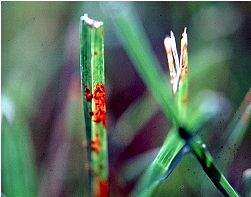|
 If
you have noticed a rusty color on your shoes after walking through the
lawn, the turf may have a disease known as rust. Late summer is the
most common time of year for rust to infect turf due to the likelihood of
moisture stress and low fertility. In most cases fungicide
treatments are not required. Nitrogen and watering (if needed) are usually
enough to allow the turf to outgrow the disease. This is the time
for a fall application of fertilizer on our cool-season grasses
anyway. Apply 1 to 1½ pounds of nitrogen per 1000 square
feet. If you follow the directions on the bag for fertilizing lawns,
you should apply about 1 pound of nitrogen per 1000 square feet. The
fertilizer must be watered in before the turf can use it. Don't
water in the evening as this increases the amount of time the leaf blades
are wet and therefore increases the chance of disease. Regular
mowing also helps by reducing disease spores found on infested leaf tips.
As is true of many diseases, rust is less likely to infect a vigorous,
growing plant. If
you have noticed a rusty color on your shoes after walking through the
lawn, the turf may have a disease known as rust. Late summer is the
most common time of year for rust to infect turf due to the likelihood of
moisture stress and low fertility. In most cases fungicide
treatments are not required. Nitrogen and watering (if needed) are usually
enough to allow the turf to outgrow the disease. This is the time
for a fall application of fertilizer on our cool-season grasses
anyway. Apply 1 to 1½ pounds of nitrogen per 1000 square
feet. If you follow the directions on the bag for fertilizing lawns,
you should apply about 1 pound of nitrogen per 1000 square feet. The
fertilizer must be watered in before the turf can use it. Don't
water in the evening as this increases the amount of time the leaf blades
are wet and therefore increases the chance of disease. Regular
mowing also helps by reducing disease spores found on infested leaf tips.
As is true of many diseases, rust is less likely to infect a vigorous,
growing plant.
Nuisance
of the Week Archives
Nuisance of the Week is brought to
you in cooperation with the Kansas
State University Research & Extension
Written by Ward Upham, Extension Associate
|

 If
you have noticed a rusty color on your shoes after walking through the
lawn, the turf may have a disease known as rust. Late summer is the
most common time of year for rust to infect turf due to the likelihood of
moisture stress and low fertility. In most cases fungicide
treatments are not required. Nitrogen and watering (if needed) are usually
enough to allow the turf to outgrow the disease. This is the time
for a fall application of fertilizer on our cool-season grasses
anyway. Apply 1 to 1½ pounds of nitrogen per 1000 square
feet. If you follow the directions on the bag for fertilizing lawns,
you should apply about 1 pound of nitrogen per 1000 square feet. The
fertilizer must be watered in before the turf can use it. Don't
water in the evening as this increases the amount of time the leaf blades
are wet and therefore increases the chance of disease. Regular
mowing also helps by reducing disease spores found on infested leaf tips.
As is true of many diseases, rust is less likely to infect a vigorous,
growing plant.
If
you have noticed a rusty color on your shoes after walking through the
lawn, the turf may have a disease known as rust. Late summer is the
most common time of year for rust to infect turf due to the likelihood of
moisture stress and low fertility. In most cases fungicide
treatments are not required. Nitrogen and watering (if needed) are usually
enough to allow the turf to outgrow the disease. This is the time
for a fall application of fertilizer on our cool-season grasses
anyway. Apply 1 to 1½ pounds of nitrogen per 1000 square
feet. If you follow the directions on the bag for fertilizing lawns,
you should apply about 1 pound of nitrogen per 1000 square feet. The
fertilizer must be watered in before the turf can use it. Don't
water in the evening as this increases the amount of time the leaf blades
are wet and therefore increases the chance of disease. Regular
mowing also helps by reducing disease spores found on infested leaf tips.
As is true of many diseases, rust is less likely to infect a vigorous,
growing plant.